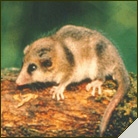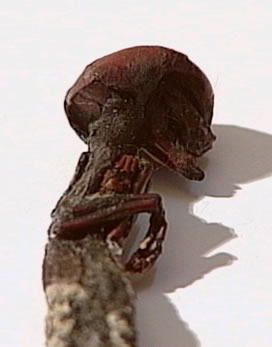- Veterinarian Arturo Mann:
-
- IT'S FINAL: "STRANGE CREATURE WAS A MARSUPIAL"
-

-
- This is what a monito de monte (mountain monkey)
looks like.
-

-
-
- A specialist from the University of Santo Tomas stated
that it is a monito de monte, a small mammal that lives in the Valdivian rainforest
and hides during the day.
-
- SANTIAGO, October 25: The mysterious creature which caused
expectation throughout Chile and which was even reputed to be extraterrestrial
in origin turned out to be a mammal known as Monito de Monte (literally,
mountain monkey). This was the statement made by veterinarian and professor
of the Univ. of Santo Tomas, Arturo Mann, who subjected the specimen to
analysis. The specialist, who was one of the few scientists who had access
to the specimen found by a family in Concepcion, stated that--based on
his knowledge and publications--he can assure with a 90% certainty that
the species is terrestrial in origin.
-
 "After a preliminary
analysis and without seeing it in "macro" fashion, I have concluded
that it is earthly. In other words, a little animal, a mammal that presents
hair, nails, fingers. It is earthly and even terrestrial, which is to say,
it's not a flying animal. It shows appendages suited to walking and even
for digging, with long nails. The body shows some damage, possibly from
animal predation or poor care [in the handling] of this little animal. "After a preliminary
analysis and without seeing it in "macro" fashion, I have concluded
that it is earthly. In other words, a little animal, a mammal that presents
hair, nails, fingers. It is earthly and even terrestrial, which is to say,
it's not a flying animal. It shows appendages suited to walking and even
for digging, with long nails. The body shows some damage, possibly from
animal predation or poor care [in the handling] of this little animal.
Terra.Cl: What is it, then?
"It is a small mammal, known as a micromammal, specifically a marsupial
and given the region it was found, would correspond with a high degree
of certainty to a "monito del monte". To reach the conclusion
that it is this "monito" or a marsupial, we are mainly based
in the fact that the anterior members present five fingers with an opposable
thumb. This means that the animal can grip branches using its hand. That's
why it's called "monito" (little monkey).
Terra.Cl: It is commonly found in the southern area of the country?
Not very commonly. It's a hard animal to find. Possibly these people came
across a moribund animal.
Terra.Cl: In this case, can we speak of a foetus or a newborn?
"It's a newborn, possibly weakened. Bear in mind that marsupials in
Chile hibernate during the winter. By not having any food, they go to sleep
in April or May, and in late August and September, they emerge in a lethargic,
weakened state to find food. This makes them more vulnerable to attacks
by other animals or to die from climactic conditions."
-
-
- Translation (C) 2002 Institute of Hispanic Ufology
- Special thanks to Liliana Nuez O.
-
-
- Comment
- From LostOnEarth
10-27-2
-
- I am looking at the body in the picture and at the picture
of the "mountain monkey" shown. Doesn't it seem as if the skull
on the body isn't proper to be the skull of the marsupial shown? And doesn't
it also seem that the placement of the skull on the spine of the body is
incorrect for the marsupial shown? and the veterinarian is only 90% certain.
-
- http://www.rense.com/general31/strange.htm
-
- this is the original story:
-
- http://www.rense.com/general31/tinyt.htm
-
-
-
-
- Comment
- From DJSmith
- djsmith9@pacbell.net
- 10-27-2
-
- Are these the same people who propose the theory that
the chupacabra is a mouse? Look at the picture of that marsupial, then
the picture of the "little humanoid". What's wrong with this
picture? How about head size for starters? Look at the mouth and nose!!!
-
- Some idiot "scientist" insists on finding a
trivial explanation for all things and proposes some thoroughly unscientific
piece of shit of an excuse of a theory and we're all supposed to buy into
it because he's an "expert"? His admitted evidence is so flimsy
that I resent you posting this article as some sort of QED explanation.
This is a piece-of-s**t theory that I would expect from a "scientist"
and nothing more!!!!
-
-
-
- Comment
- From: "Mario Pronk"
- 10-28-2
-
- Hi im Mario. When i was visiting your site i came accros
this article and started to do a little ''researching'' of my own. This
is what i found: The Mountain Monkey (Dromiciops australis)´belongs
to the Marsupialia in the family Microbiotheriiae and the genus Dromiciops.
Then i went on in search of skull-pictures and found these:
-
- If you look at the shape of the skull and compare it
withthis picture of the skull, its almost inpossible to find similarities
between the two.
-
- As Lostonearth also comments, the placement of the skull
in relation to the body (and spine) is almost 90 degrees (as you would
expect in apes and humans). In picture 1 the placement of the skull is
certainly NOT 90 degrees. Some might say this can occur when the muscles
dry out and rotate the skull, but if you look good at picture 1 and 2 you
can see that the attachment of the spine with the skull is on the back
site, not directly underneath the skull!
-
- Also the ''roundness'' of the skull does not match the
rather 'flat' skull of the Mountain Monkey .
-
-

-
- Although im not an expert in this field of science and
thus i could be very, very wrong, it is my belief that the image provided
is not that of a Mountain Monkey. But we also have to consider the possibility
that this particular creature was born deformed. I suggest a DNA test (if
possible) to make sure what this 'thing' really is.
-
- Reference: href=http://animaldiversity.ummz.umich.edu/chordata/mammalia/
microbiotheria.html http://animaldiversity.ummz.umich.edu/chord ata/mammalia/microbiotheria.html
|